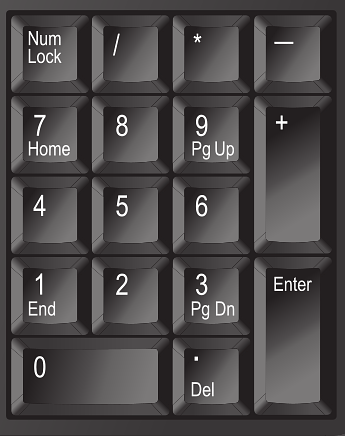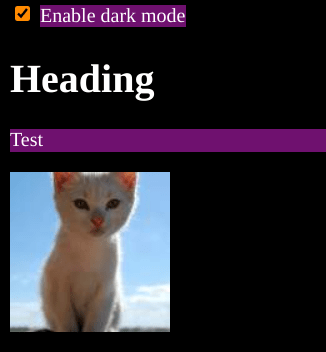
I am a bear of very little brains sometimes. I had a site which, for various boring reasons, was printing a <style> element in the middle of the HTML's body. Because <style> is a metadata element, it should only appear within the <head> element. This is OK: <!doctype html> <html> <head> <style> a { color: #f00; } </style> </head> <body> … This is an error: <!doctype html> <html> <head> </head> <body> <style> a { color: #f00; } </style> … Most mo…
Continue reading →
I'm a little bit obsessed with the idea of Semantic markup. I want the words that I write to be understood my humans and machines. Imagine this piece of code: print( "Hello, world!" ) Is that code example written in Python? C++? Basic? Go? Perhaps you're familiar enough with every programming language to tell - but most people aren't. Wouldn't it be nice to give an indication of what programming language is used in an example? Here's how we might represent it in HTML: <pre> <code> …
Continue reading →
Dan Q very kindly shared his script to make WordPress do good HTML. But I couldn't get it working. Looking at the HTML it was spitting out, the meta generator said it was HTML Tidy version 5.6.0. That's quite old! I confirmed this by running: echo tidy_get_release(); Which spat out 2017/11/25. Aha! There are a few bugs in this version of HTML Tidy, some of which are fixed in later versions. Here's how to fix them. Auto Indent doesn't work. This is fixed by manually specifying "indent"…
Continue reading →
HTML documents have the concept of an alternate representation of the document. For example, a page's header might say: <link rel="alternate" type="application/rss+xml" href="https://shkspr.mobi/blog/feed"> That tells you there's an alternative representation of the page, what sort of content it is, and where it is located. That's nice. But it's hard for a browser to tell the user what that page is. It might be able to guess from the type, but it isn't always certain. So the <link> element …
Continue reading →
By and large, the English language doesn't use diacritical marks. Even our loanwords are stripped of them; we drink in a cafe rather than the more pretentious café. This has a consequence for HTML and, by extension, eBooks. As a quick primer, modern computing gives us two main ways of displaying a letter with an accent. The first is simple - encode every single accented letter as a separate "pre-composed" character. So è (U+00E8), é (U+00E0), ê (U+00EA, and ë (U+00EB) are all stored as diff…
Continue reading →While attending IndieWebCamp in Brighton a few weeks ago, a bunch of us were talking about blogging. What is post? What should it contain? What's optional? Someone (probably Jeremy Keith said: A blog post doesn't need a title. In a literal sense, he was wrong. The HTML specification makes it clear that the <title> element is mandatory. All documents have title. But, in a practical sense, he was right. This blog post has an empty <h1> element - the document might be semantically invalid,…
Continue reading →
This has to be the most infuriating bug report I've ever submitted. I went to type in my 2FA code on a website - but no numbers appeared on screen. Obviously, I was an idiot and had forgotten to press the NumLock button. D'oh! I toggled it on and typed again. No numbers appeared. I switched to another tab, my numbers appeared when I typed them. So I was reasonably confident that my keyboard was working. I swapped back to the 2FA entry and tried again. Still nothing. Then I tried typing the…
Continue reading →
I want to make emoji bigger than the text that surrounds them. At my age and eyesight, it can be difficult to tell the difference between 😃, 😄, and 😊 when they are as small as the text. Is there a way to use CSS to increase the font size of specific characters without having to wrap them in an extra <span> or similar? Yes! Although it is a bit of a hack. This relies on 3 CSS features: src: local(), unicode-range,and size-adjust. Let me walk you through it. @font-face { font-family: &q…
Continue reading →
How do you know you're looking at an old website? You may have found a page which has lots of interesting information, but how can you tell it's a modern and relevant result? Some websites don't contain dates in their URls. There may not be a © date or publication date shown on the page. And the <meta> tags might not contain anything useful. If you're lucky, the site will look old fashioned: Unlike the BBC, most sites have adopted the "Eternal CSS" pattern. When fashions change, the entire …
Continue reading →
Yesterday I wrote about a lazy way to implement a manual dark mode chooser. Today I'll show you a slightly more sensible way to do it. It just uses CSS, no need for JavaScript. Here's a scrap of HTML which present a dropdown for a user to choose their colour scheme: <select id="colour-mode"> <option value="">Theme Selector</option> <option value="dark">Dark Mode</option> <option value="light">Light and Bright</option> <option value="eink">eInk</option> </select> It will look…
Continue reading →
I'm not saying this is a good way to make a dark mode website. I'm not even saying it's a sensible way to do dark mode. But I'm pretty sure this is the laziest way of getting dark mode on your site. And it is all done with less than a handful of CSS rules. It relies on the new-ish :has() CSS pseudo class and the positively ancient filter() CSS function. Here's the code in all its glory: body:has( > #dark-mode-checkbox:checked ) { filter: invert(1); background: #000; } …
Continue reading →
Quite often websites will encourage you to copy and paste commands into your terminal. There are a variety of reasons why this is bad - not least because someone could hide malicious code. That's usually done with a bit of CSS to make the evil command invisible, or using Javascript to inject something unwanted into your keyboard. Here's method that I hadn't seen before. Copy this code and paste it into your terminal to see your external IP address: Notice anything weird about it? Depending …
Continue reading →









